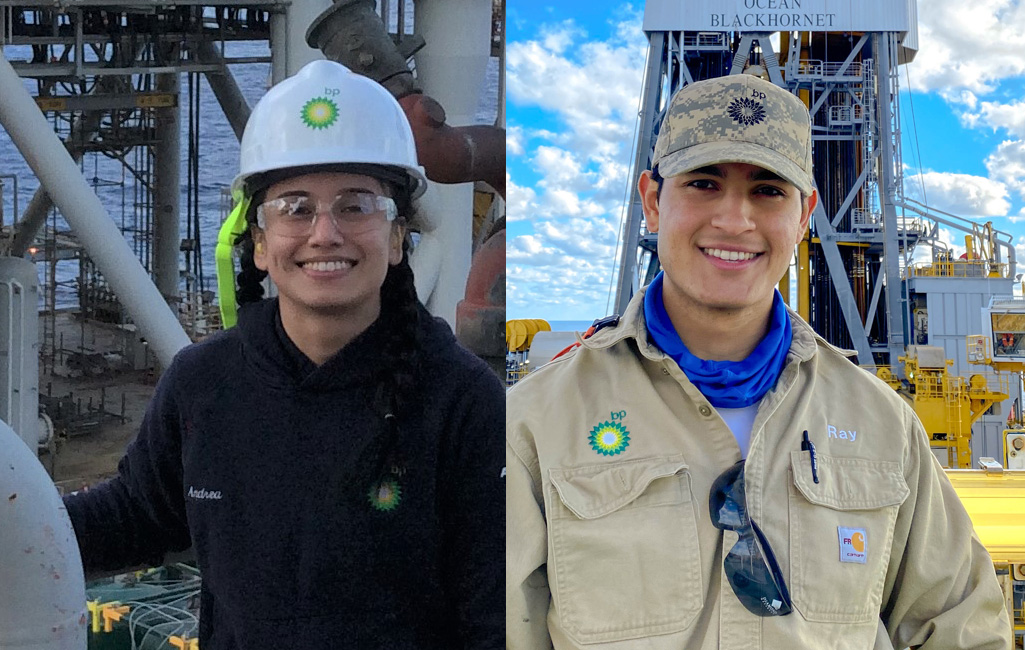By Angus Finnegan
Despite comprising 17% of the U.S. workforce, only 8% of Hispanic adults are working in STEM jobs. Out of this small percentage, just 3% are Hispanic women. Representation and visibility play a vital role in encouraging Hispanic Americans to pursue a career in scientific and allied fields, according to the Pew Research Center.
Against this background, we recently spoke with Ray Lopez and Andrea Espinosa—two inspiring engineers working at global energy company bp—about bridging the Hispanic representation gap and using their voices to encourage those with similar backgrounds to pursue a career in STEM.
To start, Ray and Andrea—can you tell us a little about what you do?
Ray: Sure. I’m a deepwater drilling engineer working in the Gulf of Mexico for bp—if you’ve ever spotted a platform out at sea from a boat or a plane—I work on one of those! I was born and raised in sunny California but studied engineering in snowy Alaska, so I guess you could say I like stepping out of my comfort zone.
Andrea: I am an electrical engineer by background, and I work as an instrumentation and controls engineer, now on-site in the Gulf of Mexico. I’ve always enjoyed exploring STEM-related subjects, which is part of the reason why I pursued a career in engineering. Outside of that, I love to travel. I’m currently planning a road trip through a few states and five national parks.
Both of you are engineers but have different disciplines. What are your day-to-day roles?
Ray: Day-to-day, I’m working with offshore personnel to provide engineering solutions and ensure we’re executing our jobs safely and efficiently—it’s quite a technical and equipment-orientated role. Currently, I spend about half of my time offshore, which as a graduate engineer definitely took a bit of adjustment!
Andrea: Like Ray, I also spend a good deal of my time offshore, but as an onsite engineer, which means I’m working in a more general capacity, helping provide engineering support to electricians, mechanics and operators at the facility. Another big part of my role is serving as the bridge between the onshore and offshore teams, liaising between the two.
Looking back, how do you think your background informed your decision to pursue a career in engineering?
Ray: Growing up in Central California, I didn’t know of any engineers that looked like me—but I did know that I wanted to find a career that was different, and that would inspire others like me to push boundaries. Thinking about it now, I think the mentorship of my school football coach planted a seed of confidence that allowed me to believe I could turn an interest in engineering into a career. He would always say that if your mind can believe it and your heart can perceive it, then you can achieve it. I know—cliché, right? But his advice has shaped my life well beyond the football field.
Andrea: Science always came naturally to me, and my parents always supported that. They would buy me science magazines for kids, and I’d run my own little experiments. One of my high school teachers noticed my curiosity and encouraged me to study engineering! Beyond that, being part of the Society of Women Engineers and the Society of Hispanic Professional Engineers truly shaped my career and guided me. It was because of them that I ended up at a National Engineering Convention, where I was recruited by bp for my first internship.
You’re both passionate about bringing underrepresented communities into the STEM field. Could you tell us a little more about this?
Ray: I think as a first-generation American who’s found their dream career, I’ve always felt a responsibility to spread opportunities and awareness to those with similar backgrounds to me. I’m a proud member of the Society of Hispanic Professional Engineers and within bp, I’m active in the Energía business resource group, which vocalizes the role and contribution Hispanics make within the organization. I also deliver regular talks about my career progression to high school students through the National Academy Foundation, which is a national organization that seeks to empower underrepresented youth. They might not want to be engineers, but it at least shows them that there are opportunities outside of what they thought possible!
Andrea: Similar to Ray, I’ve always found it important to pay it forward. As a fellow first-generation American and the first in my family to attend university, I struggled a lot with impostor syndrome when I began my career. What gave me confidence was finding an encouraging and supportive community, whether it was bp business groups such as Energía and the Women in Offshore Network, or inspiring mentors—the community around me has helped me build confidence. Now, I seek to uplift others, volunteering at recruiting conferences and speaking to college students who are unsure about what their careers might look like. I see myself in their shoes just a couple of years ago, I think about how far I’ve come and I feel excited for the journey ahead for them.
If you could give one piece of advice to a young Hispanic person thinking about a career in STEM, what would it be?
Ray: Ask lots of questions—as many as possible! The range of different careers within STEM is just incredible, so finding out as much as possible about what’s on offer is a great thing to do at a young age. Curiosity and ambition can take you far in life!
Andrea: If you keep an open mind and believe in yourself—there is no stopping you! Of course, building trust and confidence is a process. But for me, the most important part is knowing that I deserve to be there. Even if my family has a different background, all that matters is the work that I do and the attitude that I bring to the table. That’s what’s helped me grow into the proud engineer I am today.
For more information on engineering and other careers at bp, visit bp.com.



